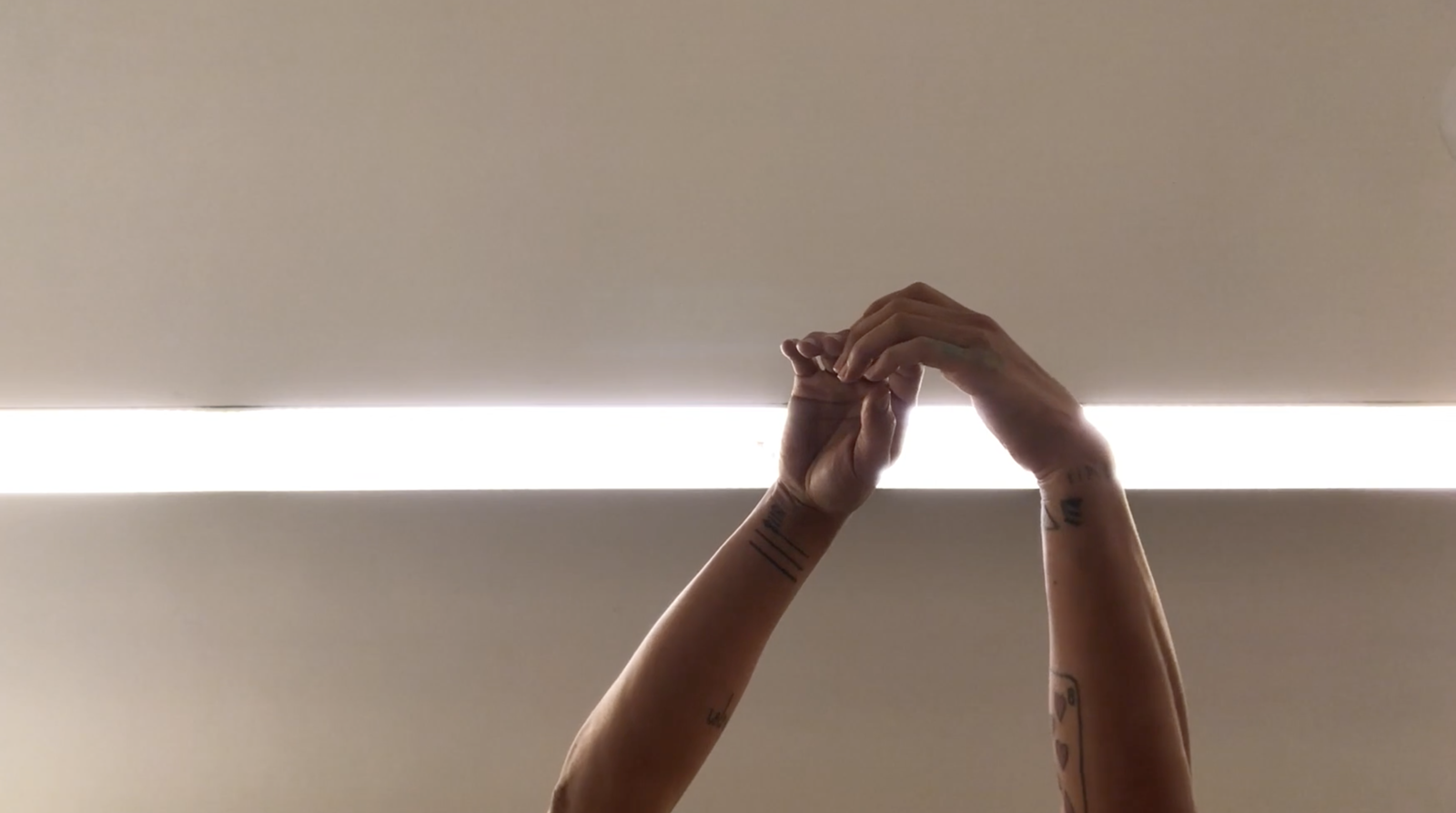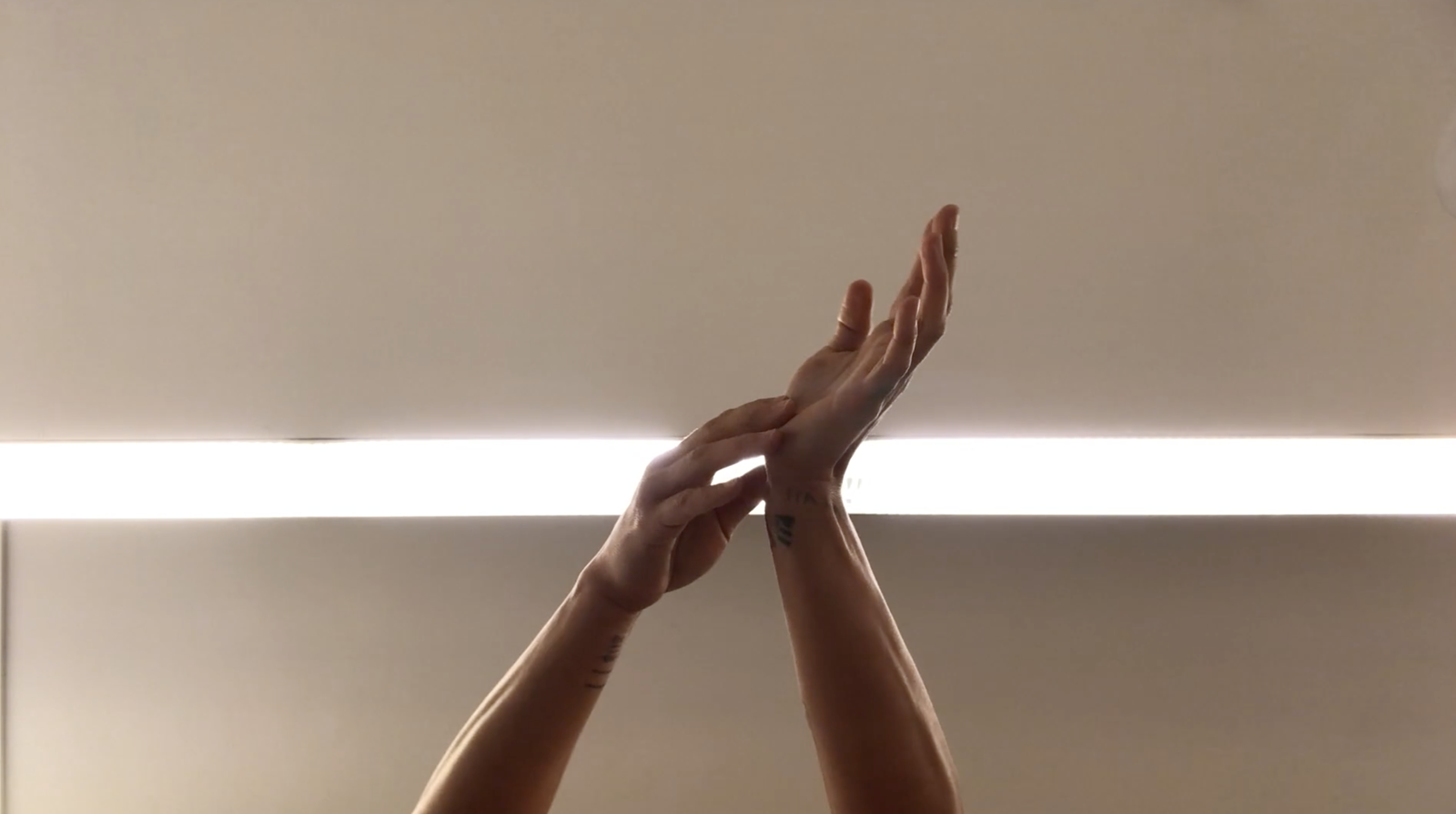Haptic Entanglements 2
THE BODY IS NOT AN OBJECT
an invitation to embodied consent practice
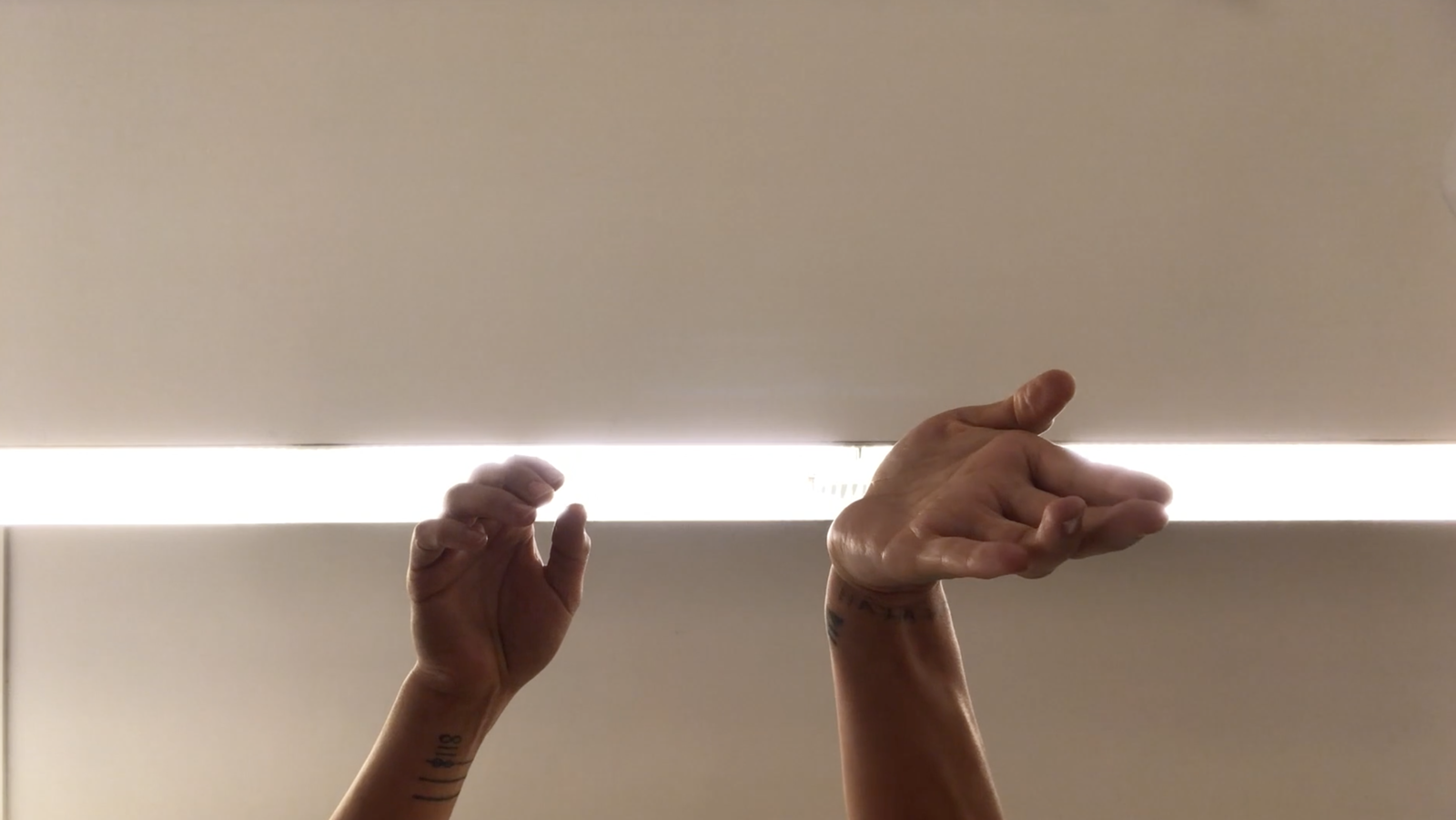
Still from 1,000 caresses, 2018, von Tosh Basco
In texts, questions and exercises, artist Joy Mariama Smith invites us to approach an embodied practice of constent that takes sensing together as its starting point and understands consent less as a contract than as a complex field of relations.
by Joy Mariama Smith
published on 21. September 2021
Gloss
Access - something those in non- dominant culture are busy with linked to power and privilege or linked to oppression and colonial histories.
Accountability - works best in community, present in shame and blame free spaces.
Agency - necessary in any and all learning environments, a foundation, useful tool in integral in a healthy ‘no’ practice.
Check in - a process practice that I do in the beginning of each situation that I facilitate in order to figure out what type of space I need to hold and what states are in the room.
Empathy - feeling sensing the other. really. strengthens emotional intelligence.
Positionality - naming where I am, so I can control my own narrative. something I do to help me navigate in various a variety of contexts - the ’kryptonite’ of projections.
Trust - the speed we are moving at.
White supremacy culture - the context we are in.
Questions
1. How do you personally define and understand consent?
2. Have you ever had a conversation about consent in the context of theatre and performance?
3. Is there a relationship between one’s own culture and/or current context and one’s understanding of consent?
4. Have you worked with people who define consent differently than you do?
5. Do you see consent the same way when you are performing, as when you are in the audience, or when you are directing or producing?
(Questions adapted from: Learning Good Consent. See references list.)
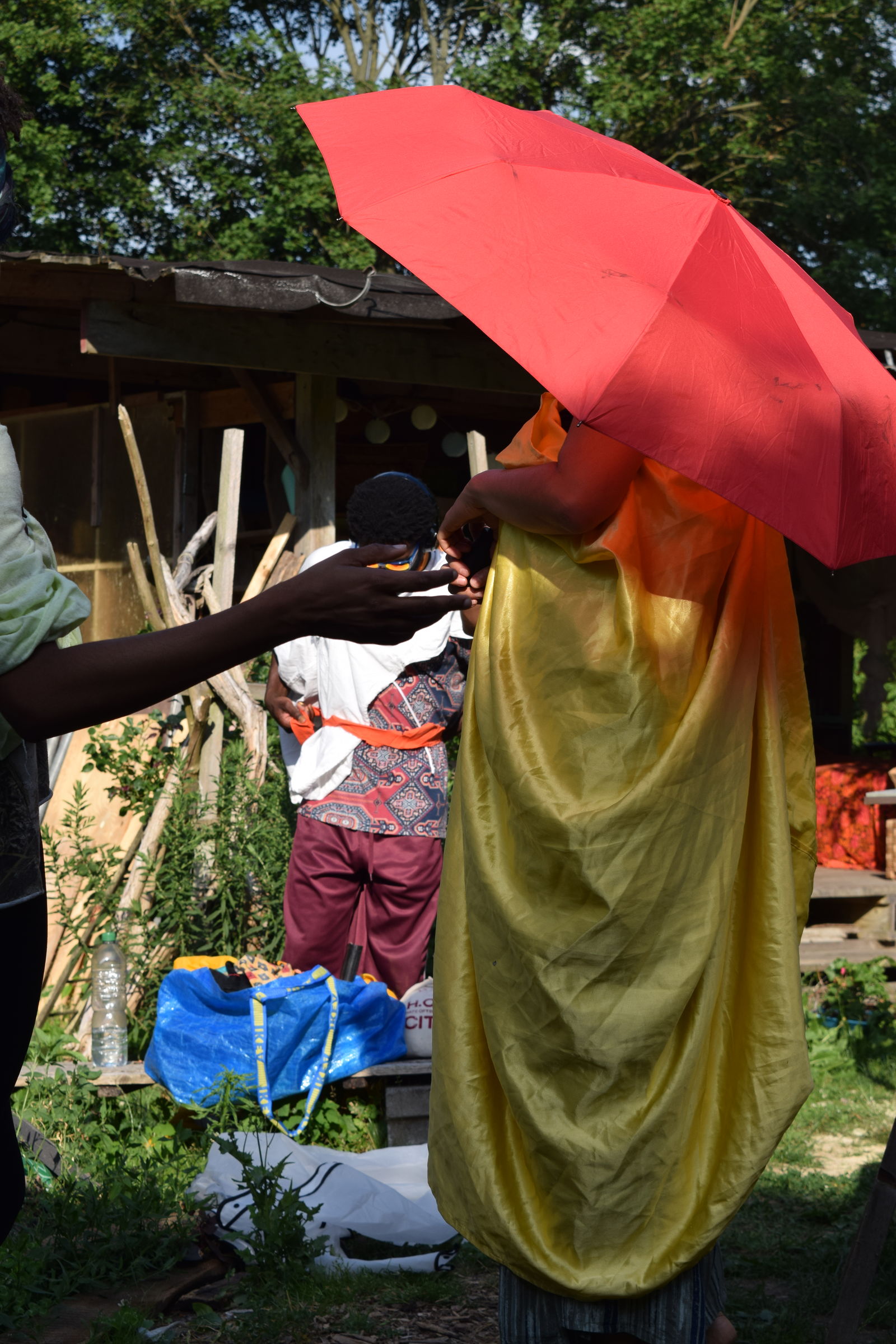
Red umbrella and yellow/golden fabric as dress, exterior shot by Tom O'Doherty
Autonomous touch - warm up
1. Find a comfortable position. It can be seated, standing or lying down. Take a moment to find stillness. Place both hands on your belly or place both hands on the top of your knees. You can let them rest there. Take a moment to take 3-5 deep breaths.
2. Continue breathing deeply and bring your attention to your hands. Focus simultaneously on the place where your hands are touching and where your body is touching your hand. (This should be belly or knees if possible).
3. Keep breathing.
4. Move both hands up to your sternum or chest and rest them there. Be aware that as your chest is touching your hands, your hands are touching your chest. What does it feel like? Do any thoughts, emotions, sensations arise? When was the last time you were touched there?
5. Breathe.
6. Move both hands and clasp them behind the back of the neck. Notice that your neck is touching your hands and your hands are touching your neck. What does it feel like? Do any thoughts, emotions, sensations arise? When was the last time you were touched there?
7. Keep breathing.
8. Relax your jaw and soften the back of your neck.
9. Move your hands from the back of your neck to cover your face. Use as much pressure that is comfortable for you. Acknowledge that as you touch your face your face is also touching your hands. Do any thoughts, emotions, sensations arise? What does it feel like? When was the last time you were touched there?
10. Continue breathing and move your hands to touch other parts of your body in the following sequence (or a sequence to your liking) and notice the reciprocity of touch. As you go through the sequence, continue to ask yourself and take a self-inventory based on the following questions: Do any thoughts, emotions, sensations arise? What does it feel like? When was the last time you were touched there? Remember to breathe. Here is the suggested sequence: Crown of the head, elbows, side of the torso (near bottom of ribcage), lower back, tailbone & pubic bone, genitals, top of the thighs, back of the knees, calves, ankles, feet (top or soles).
11. After touching and being touched by the last body part in the sequence clasp your hands together, interlacing your fingers. Take 3-5 deep breaths to close.
12. Observe how you are feeling (emotionally, physically and otherwise) and reflect on your experience
Check in: Hi, I’m glad you are here. How are you feeling? Emotionally? Physically? Energetically? Otherwise? What do you need in order for you to feel, good, comfortable FEEL right now? Thanks for being with me, and showing up I appreciate it, I think I/we can learn a lot from this interaction. I am going to ask later how you are feeling again and you can read/ keep reading/stop reading at any time.
Invitation: I want to invite you to read this text out of sequence, to read it in a sequence that you choose or to even practice free reading² and scan the text and see what emerges. Treat this text as a dance partner, treat this text as responsive, as living and breathing. Wander around, trust yourself, value the connections you make, play and be receptive to non-dominate modalities of cultivating knowledge.
Positionality: I want to let you know from what perspective position I am writing this from. To start, I want to tell you that I am at home, sitting at my desk and on this particular day it is sunny. I live in europe. I was born in the mid 70s and I am Black, or a person of color of Indigenous and African diasporic descent. I was raised by a single parent, and I am an orphan. I am an only child, and I am american. I am an expat who has lived in europe for a total of 8 years. My mother was an english teacher. I am nonbinary/agender, demi-sexual and queer. I have survived sexual violence. I consider myself to be a gentle activist. My zodiac sign is Cancer, and my rising sign is Leo, but this is by speculation as I do not know what time I was born. I am also from the Northeast part of the united states. My mother tongue is english, I used to be fluent in French. I can understand some Dutch, German, Spanish and even speak it enough to order my vegan food. (read: I am vegan)I have a disability that is not visible and is very much present (read: chronic pain). I come from a family that is poor ‘working class’. I am polyamorous and kinky. I’m a freelancer…
Having said all that, what is your position in relation to mine?
This is how we can begin relating.
Do you have agency right now? How can you tell? How are you feeling? In what ways are you performing? Can looking/observing/watching be an act of radical care? Is there enough space for empathy?
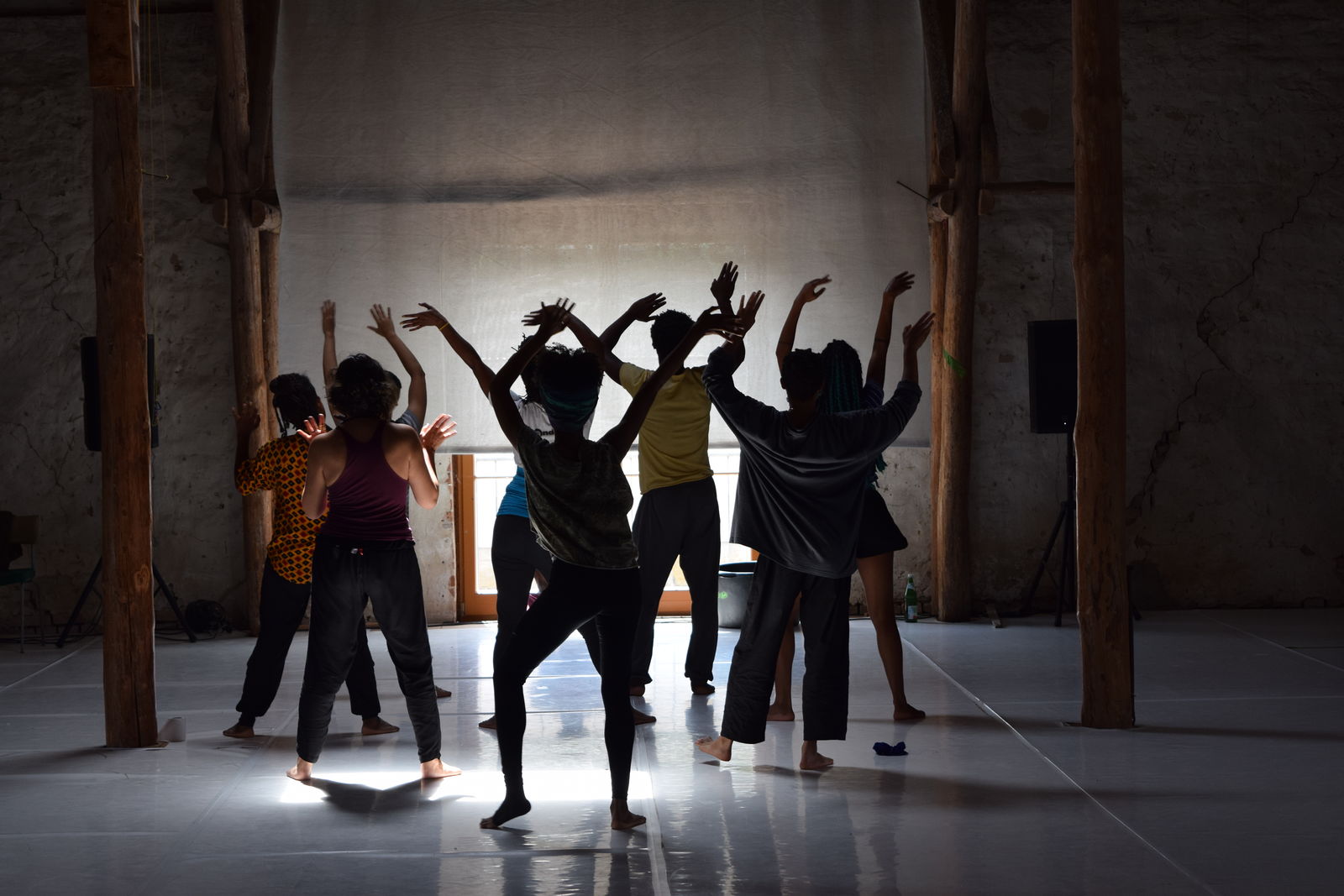
Silhouette of dancers with hands up, interior studio shot by Tom O'Doherty
What are we training for?
When I was trained as an artist/performer, (similar to being trained as an athlete) I was taught that my role as an artist was to push people's boundaries, and even surpass my own for the sake of the art. This translated into my training as an audience member. My training as an audience member was to view work and to have my boundaries pushed and this transgression of boundaries, (on either side) that then became normalized was part of my duty. There is something that happened in contemporary art, where, I used to be very generous- like: carte blanche. ‘Do what you want. I’m up for whatever, I’m participating, I’m all in!’ I used to be that type of audience member but then I started thinking - is it helping the artist if I’m just completely open all the time? Moreover, am I completely open all the time? Is it appropriate, healthful, caring, nourishing, challenging, educational, healing, transformative, possible to be open all the time? What does a foundation and training around being open all the time do to an understanding of navigating consent?
It is time to hit the reset button. It is time to move away from the transgression of boundaries as something that is normalized, and shift towards sensing feeling together. sentire + con = consent
Con / sider con / sentire
When you/we consider consent, is y/our go-to image thinking about physical touch and the skin as the primary boundary? I want to reframe how I/you think about touch, by zooming out a bit and taking a potentially non-normative, non-dominant somatic approach. Even in the context of consent and theater and performance, nested within the notion of tactile entanglement, in order to get a more accurate picture, I/we³ have to zoom out. I want to see if you can trust me for a moment, or just try to because I am going to talk about consent, but I need a bit of trust from you in order to do that.
When I talk about consent, you should know that I go back to the roots of the word. I look at it and dissect it. That is where I start my understanding, so I want to start there. The root of consent comes from consentir/consentire - con + sentir(e)⁴ meaning sensing together. Sensing, feeling, perceiving etc. These things (the senses) are not solely based on the haptic but can be viewed through a haptic lens. The haptic is too reductive. I want to broaden strengthen our shared understanding of consent, by moving through a more expansive notion of touch and by sensing beyond touch. If we can do that, we can disrupt the current hierarchies of the senses and enter the consent landscape from a body based sensorial experience that is not only limited to touch.
How do you understand touch?
How do you understand sensing?
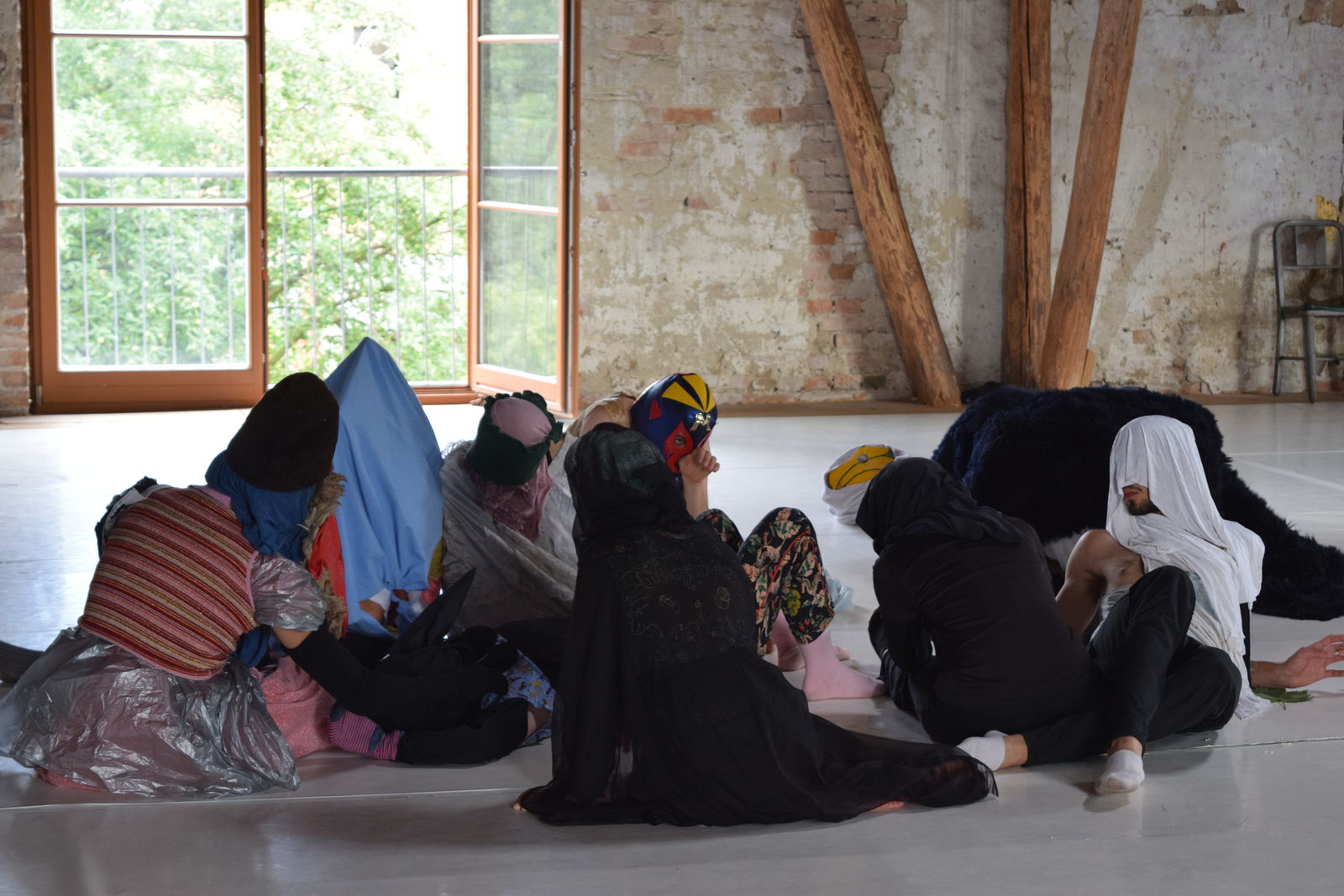
Group of people on floor with fabric covering their face, interior studio shot by Tom O'Doherty
Boundaries
Consider touch in its most simplified state as a meeting of two or more boundaries. Now think of the many different types of boundaries there are: emotional, physical, intellectual, sexual, energetic, spiritual, cultural, psychological.
How do you sense and understand your own boundaries and how do you know when they are transgressed?
What happens in the moments you/I/we experience discomfort? Or when a boundary is crossed? When and where do I/you/we learn to assert and express boundaries?
Another way to conceptualize embodied consent, is to check and see if there is space to express a boundary with no consequences.
Context
If I/we are going to work towards understanding embodied consent, we/you/I need to be able to understand the context and culture we are already immersed in. Power, privilege, oppression, and access are all part of a constellation of things that make up certain aspects of how we/you/I experience culture.
Once we understand where we are, we can work together to move through have a foundation built on the notions of agency, trust, vulnerability, accountability and access. I am offering a starting point where we/you/I name things that are systemic and therefore part of the equation. These things affect how you/I/we view things. Which means, they also affect how we understand, interpret, create and respect boundaries.
From where I am sitting⁵, I cannot talk about consent without acknowledging some behaviors or characteristics of white supremacy culture⁶ specifically in relation to theater and performance. The two that come to mind are ‘The right to comfort’ and ‘Objectivity’⁷. In broad strokes ‘the right to comfort’ is a behavior that is based on the belief that those in a position of power deserve to be the most comfortable, and ‘objectivity’ is a behavior based on the belief that there is such a thing as neutral and, it also sees including emotions in decision making as a negative thing or devalues emotional intelligence. You/I/we need to value emotional intelligence in collaboration with other types of sensing if we are actually going to work on consent. Consent is not transactional and is not based on logic.
As a counterpoint, I want to call in emotional and somatic intelligence and de-prioritize intellect and logic. I want to invite in other systems of autonomous and collective understanding in order to enter the dynamic relationships that come into play when it comes to consent. To that end I want to offer a series an exercise that can support us (again you and me) in starting to shift our understanding of consent (feeling together) with regards to theater and performance. Begin by thinking not that consent is a contract, but instead a complex field of relations. Vibe is real. Feelings are valid. Intuition is valid.
Can you take a moment to breathe, look outside, look at something in the distance, take your eyes away from the page and as you take a deep breath [inhale…...exhale….] notice how you are feeling. How are you feeling? How is your body feeling? How is your mind feeling? Are your thoughts racing, are you distracted? Is your heart rate fast or slow? Are you comfortable? How do you know if you are comfortable?
Can You Relate?
Within this complex field of relation (you can also think of it as a spectrum or a constellation) we also need to think about empathy and agency as feeling based concepts that can support us in understanding consent. If we are going to relate, then we need to be in proximity to each other. Not just proximity, but also another shared relation. There is a word for this: propinquity. Propinquity is a word that hybridizes kinship- a closeness or a relation of a type of intimacy, and proximity- a closeness or relation of space and or time. For example, if there is something that you like or a person you have an affinity for, you might demonstrate that by being near them. To oversimplify, being near and/or moving towards the things you like and moving away or being far from the things you don’t like. Moreover, understanding that these relationships can and do shift depending on the context(s). Propinquity, when applied to feeling together, can provide clues in terms of understanding our own preferences when it comes to consent, even when we do not know what we want, and of course when we do (know). In the case that we do not know what we want, we can use propinquity as a means of assessment. Not only as a means of assessment, but also as a navigational tool. You can Can you experience propinquity as a barometer of consent? Check your vibe.
Moving Towards
In the context of [stage] performance⁸ I am faced We are often faced with a series of binaries and hierarchies that do not support the holistic understanding that is needed in order to incite a consent based culture. Hierarchies do exist and those hierarchies come with different access points (if any) to power, agency, vulnerability, safety, boundaries, privilege, comfort and more. Consider the many constellations of people that make up stage performance settings, now think of the dynamics in those relationships. Do those dynamics include elements that nurture a consent based culture? The body is not an object. Beware Be Aware: labels, signifiers and designations can often dehumanize the body. This dehumanization moves us away from empathy and agency, which we need are vital ingredients in consent. I want to move towards practices of empathy and agency. Can you and I start from a relationship that is more horizontal? Can we, include in that relation, possibilities for each other to express and understand things differently, based on a more informed intersectional approach? Once we understand and acknowledge these differences we can then actively engage with empathy and agency, and accountability. This is moving towards a consent culture.

Cluster of people huddled together/group hug, interior studio shot by Chani Bockwinkel
Embodied Consent Duet
1. Relax your anus.
2. Find a partner or partners.
3. Establish boundaries between you and the other(s).
4. Do not physically touch. (Refrain from touching).
5. Notice how you are feeling emotionally, physically, psychically and otherwise.
6. Make eye contact with each other- this can be short (a glance) or long (a gaze).
7. Sit next to each other.
Make ear contact
8. Listen to each other without talking.
Imagine yourself as other
Find where you end and another person begins
9. Find the common body between the you (plural) without intersecting (do not touch).
10. Lean towards each other, lean away from each other, lean left lean right or lean to one side, then the other side. Lean forward and lean back.
11. Pretend that you care about the other person(s).
12. Imagine that a connection has been established.
13. Extend that connection into the environment.
14. Notice your environment Observe and listen to your environment.
15. Find your own way to complete this exercise…
References / Ressources
- Okun, Tema "White Supremacy Culture" in Kenneth Jones and Tema Okun, Dismantling Racism: A Workbook for Social Change Groups (ChangeWork, 2001), available at https://www.dismantlingracism.org/uploads/4/3/5/7/43579015/okun_-_white_sup_culture.pdf
- Crabb, Cindy’ “Learning Good Consent: On Healthy Relationships and Survivor Support”, AK Press, 2016
- Abram, David, “The Spell of the Sensuous :Perception and Language in a More Than Human World”, Vintage, 1997
- Smith, Joy Mariama, “Extended Choreographies of Consent/ E.C.C.O.” [Zine], 2021 (2nd limited edition printing), available at https://drive.google.com/file/d/1tOydDHah-tRMv6o4Qi_zeJ86u5UmkUEO/vie
1 A style of reading and a proposed exercise you can engage with here
2 by ‘we’ I am referring to you-the person reading this text, and me- the person writing this text
3 con- from Latin root meaning ‘together’, sentire- from Latin root meaning sensing or feeling.
4 I am sitting in the body of a queer non-binary disabled black person born in the 70s and socialized as female.
5 A set of characteristic and behaviors as identified in text by Tema Okun. See reference.
6 These are two specific characteristics named in the White Supremacy Culture text. See refenreces.
7 This is as opposed to the performance of everyday life. e.g. performance of gender, performance of power, and inhabiting other social constructs.
